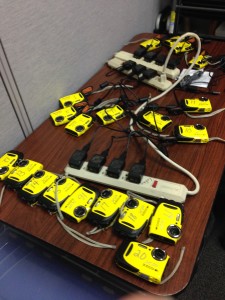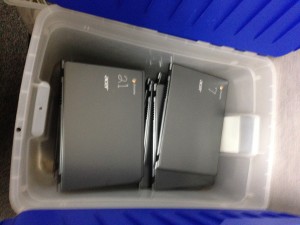In my job as STEM Learning Facilitator I travel hundreds of miles each month around the 6 counties in my region, but at times all around our state. One of the toughest challenges we face is the technology integration piece. Many (way too many) educators still possess minimal skills or knowledge in integrating technology, have limited access to technology, are blocked from most online collaboration enabling applications, are unaware of what is available (since it’s blocked) and misinterpret laws protecting students from online dangers. In addition, any use of technology (“We go to the computer lab for 30-45 minutes a week.”) is perceived as implementing the “T” in STEM effectively.
Furthermore, each school district has it’s own network, protected by their own security systems, and they tend to not relinquish access to those networks easily, even for someone coming in to train their educators.
So to enable us to do a much better job of delivering quality professional development (PD) we came up with the idea of a mobile lab to control for many more of the variables of access and hardware that have frustrated us and the participants in the PD sessions we offer.
I’m not going to spend time here explaining fully what led to the choices we made, but know there was thought that went into those choices. Cost was a big factor.
We chose to go with 21 Acer Chromebooks. The lab also contains 3 Verizon Mobile Hotspots so we have connectivity almost everywhere we take the lab that isn’t filtered, and 21 waterproof digital cameras so we can model integration and archive teachers’ learning to their own free Flickr accounts which we set up during trainings. The wireless hubs also enable showcasing and utilizing applications like blogs, wikis, Twitter and more during trainings and presentations so educators and administrators can perceive their education value. Thankfully, this also tends to foster discussion about safety and other issues that we can then deal with in an open way based on at least this initial experience.
Right now the lab sits in plastic tubs, but part of our plan is to develop a cheap, light transportation system that will also keep the components of the lab in good shape. We already have some ideas for that that I plan to share later.
(Below right) 21 Fuji digital cameras being charged for the first time – we chose these because they have fewer moving parts (the lenses don’t open and shut like most point and shoot cameras do these days), they are waterproof to 10 meters deep and are purported to survive being dropped from 5 feet … so hopefully they will take a bit more rough handling and if the opportunity arises could be used underwater … we’ll see. 
We’ve already had some success, even before obtaining the MSTL (Mobile STEM Technology Lab), in persuading one reluctant school district to open up blogs, wikis and Flickr on a trial basis to one school. We had discussions with teachers, administrators and school board members and demonstrated the educational value they were missing and explained that they would not be losing their E-Rate funding (a common misconception) if they allowed access to any social networking applications.
That promising experience actually helped us secure the funding for the MSTL.
We tried out the MSTL in a training last week in a classroom in the center of a high school with a very low, heavy metal ceiling and lots of suspended metal ductwork. We suspected in advance that that would slow connectivity, and it did, but we also know that most of the training sites we utilize don’t have that issue (and we’ve used the hubs in these locations and achieved good connectivity), so we are confident. I’ll keep you apprised of how things go!
Learning is messy!


Yay for cameras among a school’s technology arsenal! It’s so easy to overlook, but they’re awesome. As an elementary & middle school science teacher I found digital cameras an incredibly useful and engaging tool; great uses on plant, animal, and geology walks, where then kids would create PowerPoint presentations to summarize and present their observations. Also: when doing frog dissection, students loved worked in partners and demonstrating mastery by finding organs on their own, taking photos of each, and labelling within PowerPoint, which was an easy and enjoyable assessment.